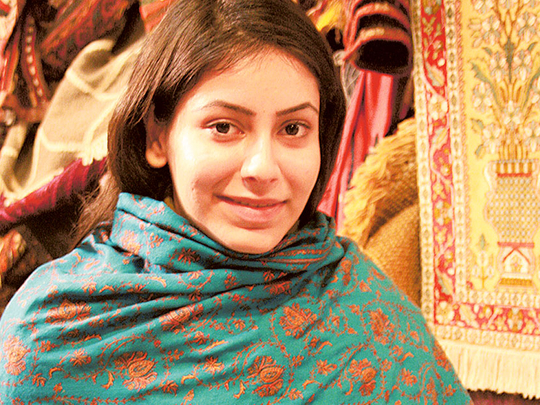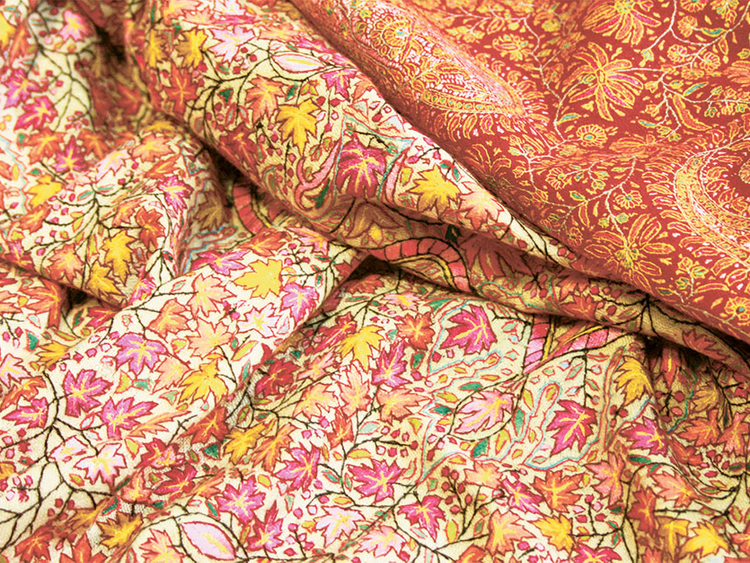
Rich, handwoven or embroidered shawls never seem to go out of fashion. In fact they remain in demand the world over. While Bhuj in Gujarat is known for its coveted soof and kharek hand-embroidered shawls that are woven with craftswomen’s mathematical formula, a manufacturer in New Delhi produces yarns and shawls for luxury brands.
Shawls were commonly used in earlier times and remain as much a part of many cultures even now with a dual purpose — keeping the body warm and to compliment a costume. In olden times, Kashmiri weavers worked together simultaneously on one shawl and this could take couple of years, depending on the technique, design and colour palette involved.
The painstaking procedure is the reason why some antique forms of weaving have not passed down from one generation to another and the younger generation has opted for other professions. But on the other hand, some manufacturers have been working towards reviving those crafts.
Kutch, Gujarat-based Shrujan Creations, which began its operations in 1969, got involved in manufacturing of shawls in 1999. Ami Shroff, project director, Shrujan Creations explains, “Initially, merely 30 women belonging to one village and one community worked with us. At present, we are spread over 120 villages of Kutch and Banaskantha, working with over 10 communities and 3500 artisans.
“Once the shawls are hand-woven in pure wool in Bhujodi village, the artisans embroider the shawls. Out of these, the most popular are the ones done in Soof embroidery. It might sound simple, but only after a few trials we were able to standardise the required quality for the artisans of the Soof community. The 350 artisans who work on the Soof shawls belong to the Marwada-Meghwad community, who migrated from Sindh in Pakistan, post the 1971 Indo-Pak War.”
Before coming in contact with Shrujan, the weavers were used to weaving very coarse shawls. “But once they began working with us, we started procuring soft wool for them from Ludhiana in Punjab. Over the time, the weavers themselves developed contacts in various parts of the country and procured soft wool, cotton and silks and have created an identity for themselves,” Shroff says.
Interestingly, soof shawls are woven with the craftswomen’s mathematical formula without any pre-drawn design, as the design is in the head of the craftswoman.
Shroff says, “The artisans count the warp and weft of the base fabric and develop designs. The basic units of design are the lath, lehrer and soof. These units are the starting points for the craftsperson’s calculations. And the artisans claim that if they forget the numbers, they have to remove all the work they’ve done and restart the procedure.”
A heavy shawl can take from six to nine months to embroider and the buyers come from all walks of life. Importantly, the artisans at Shrujan are all women. “That’s because the embroideries are part of the cultural identity of the women belonging to different communities and men in those regions do not embroider,” Shroff says.
In India, one cannot talk of shawls without mentioning the name of the northern most state Kashmir. While at one time handwoven jamawar, pashmina and shahtoosh were among the most famous shawls manufactured in this region, several traders are now producing machine-made shawls and concentrating less on handwoven works.
To resuscitate the rare art of producing jamawar, a first-of-its kind exhibition was also held in the country few years ago. The aim was to explain to the public the art of painstakingly producing ancient jamawar shawls and making them aware on how the antique form of weaving was done.
As for pashmina, goats are reared by nomads in the Changthang area of Ladakh, at an altitude of more than 14,000 feet where winter temperatures can plummet to minus 50C. The finest pashmina wool is usually hand-spun by women. The artisans then embroider them with intricate designs.
According to an expert, “The term pashmina is being misused by manufacturers around the world and an explosion of fakes are a worry for both artisans and traders. Few from the younger generation are involved in this art, as the lure of cities has led many to abandon the craft and they have taken up more lucrative jobs.”
However, Delhi-based Carpet Cellars, which has been dealing in exquisite carpets since 1975, boasts of some superb varieties of shawls. Dhruv Chandra, co-owner, Carpet Cellars, informs, “We sell pashmina shawls that are hand-woven from the finest hand-spun pashmina threads.”
While the outlet’s pashmina silk collection, using the best mulberry silk, is tried and tested by its regular buyers, it also manufactures shawls for luxury brands such as Gucci, Loro Plana, Ermenegildo Zegna, Missoni, Ralph Lauren and Cerruti, who buy shawls from Carpet Cellars in bulk and sell under their own brands.
The Chandras have also introduced shamina, an alternative to the banned shahtoosh shawls. The environment-friendly shamina shawls are made from the first shearing of lambs.
“For a single shahtoosh shawl, three to four antelopes have to be killed. While the killing of the animal is not only banned, it is also a criminal offence. So, instead, we are making use of the world’s softest, lightest and warmest wool derived from the lambs,” Chandra says.
Shahtoosh, however, continues to be manufactured and sold by unscrupulous traders in black market under-the-counters in large numbers. A study done by scientist Dr George Schaller in 1995 claimed that poachers in the Changthang Nature Reserve still killed antelopes and there was a cross-border trade with the Kashmiris, known to be the only people in the world who can spin and weave this fabric.
Detailing about another extremely popular variety pashmina, Chandra says, “Today, when we talk of purity, the most important aspect to take note of is the micron used, about which not many are aware of. While the human strand of hair is 75 microns in thickness, in shamina, we use only 13.5 micron, which is of the softest, lightest and premium quality. Not possible to spin it on machine, it is hand-woven because of the very fine and short length of the fibre.”
Woven in Kashmir, according to the traditional methods and techniques employed by the ‘shahtoosh’ weavers, the beautiful shawls help preserve the time-honoured crafts. Luxuriously warm and exquisitely light, each piece is unique, taking the craftsperson from several months to years to do the weaving.
Hand-embroidery on both shamina and pashmina shawls is extremely time-consuming and weavers in Kashmir generally work in the comfort of their homes during winters when due to extreme weather conditions they are unable to work in the fields.
The manufacturers, meanwhile, are not sitting on their laurels. Chandra discloses, “We are also reviving the high quality kani and dorukhi (double-sided) jamawar shawls that were made for the Indian maharajas dating back to the 16th century.
“In fact, we possess a number of antique Kani Jamawar shawls that are 100 to 200 years old. These are part of our family collection. Because of their historical relevance, and exceptionally good quality, we manufacture imitations of these at our units in Amritsar and Ludhiana.”
Dorukhi, a woven shawl, is produced in a manner that it has the same effect on both sides. The perfect workmanship is a combination of both weaving and embroidery, which is done in such a refined manner that distinguishing the front from the reverse side is often not possible.
During the time of Napoleon Bonaparte, the first emperor of France, several Indian maharajas had gifted him Dorukhi and other varieties of shawls, which his wife Josephine was exceptionally fond of. She decided to make them available for the European market, as in Europe it had become extremely fashionable to own handmade products from India.
Mechanisation soon led to manufacturing products in large quantities, recreating the shawls on jacquard looms, instead of being hand-woven. The modified version of these is now known as Paisley shawls.
So how does one differentiate between a good quality and a fairly acceptable shawl? Chandra says, “It comes in with a bit of experience. Good quality shawls are generally very soft. Also, the difference between a machine-made and a hand-woven fabric can be ascertained by noticing the precision-like regularity in a machine-manufactured design, whereas in a handwoven shawl, there may not be consistency or regularity in design.”
Nilima Pathak is a journalist based in New Delhi.













